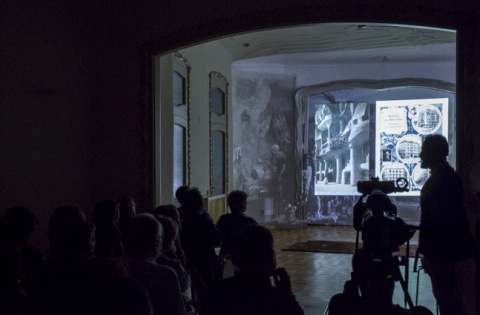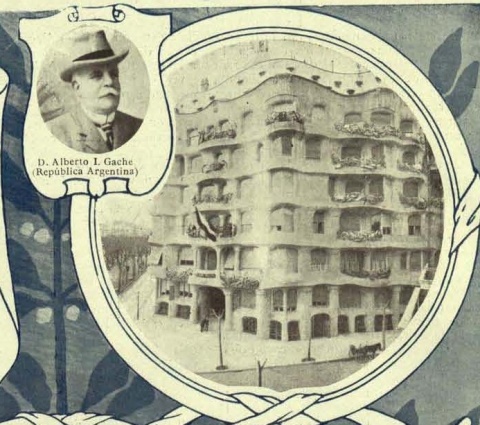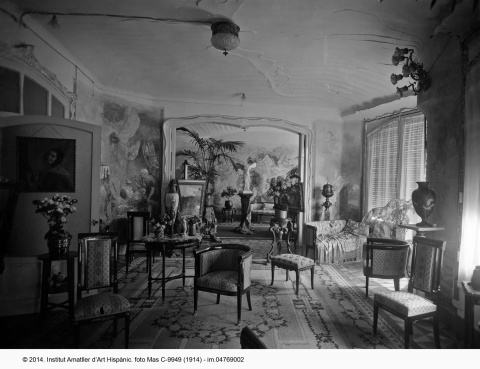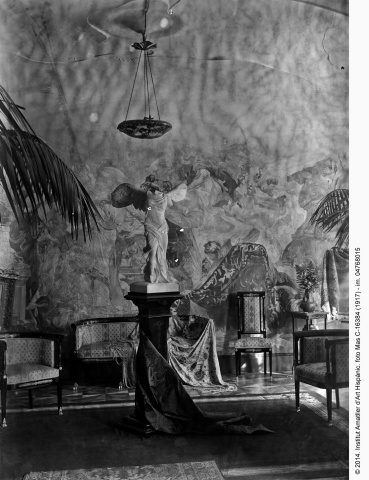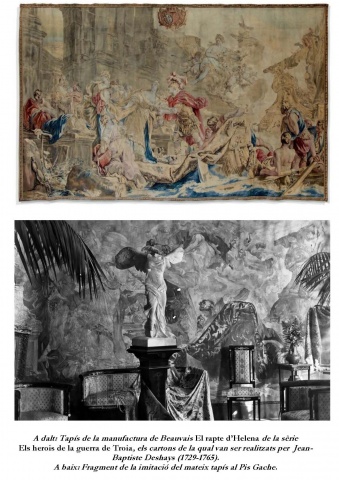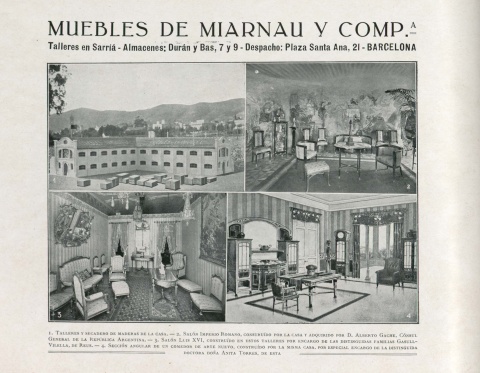Aleix Clapés and the artwork of the “Gache Apartment” in the Casa Milà.
Alberto I. Gache (Mercedes, Buenos Aires, 1854 – Montevideo, 1933), Consul of the Republic of Argentina in Barcelona, resided on the first floor, second door, of the Casa Milà from 5 August 1911 to late 1919.
On 26 September 2014, a visit and a talk were organised at La Pedrera to acquaint the public with the décor of the “Gache Apartment” and the diplomat’s art collections, in particular the now-lost wall-hangings painted by Aleix Clapés (1846-1920) for the Gaudí apartment’s sumptuous lounge. The attached document gives a detailed description of the research.
Carlos Alejandro Lupercio presented new documentation on the painter and the depicted scenes of this commission, a fascinating and landmark work in the pictorial decoration of the time.
“At the time I resided in Barcelona’s most striking and bizarre building, […] on the corner of Passeig de Gràcia and carrer de Provença, of which remarkable stories were making the rounds. […] That cyclopean mansion with its great fenestration, its overhanging and perturbing balconies and particularly its thick twisted columns that seem to falling apart, […] seduced me, drew me, as does everything that departs from vulgarity.”
Alberto I. Gache. Corazones y cerebros; published by Juan de Gasso, Barcelona, 1924
Alberto I. Gache was appointed as Consul General of Argentina to Spain on 15 August 1902 and performed his duties until 11 June 1927, when he was appointed as the Commercial Attaché to the Argentine embassy in Madrid.
According to the society columns of the time, Señor Gache moved in intellectual and political circles and enjoyed an active social life. His parties were attended by the crème de la crème of Barcelona society. He penned a number of self-published books, La Argentina y sus grandezas, La Argentina en marcha, Cuentos del tío ilustrados por su sobrino, and the aforementioned Corazones y cerebros, a volume of memoirs in which he gives an account of the prominent personalities he met over the years, among them Àngel Guimerà, Frederic Rahola (lawyer, editor and politician) and Rubén Darío. In the book, Gache describes in detail a visit by Rubén Darío to his apartment at the Casa Milà. This part of his memoirs is also included here.
Although Gache was no longer in Spain at his death, the La Vanguardia published a remarkable obituary of him:
“Mr Gache was well known in Barcelona, having lived here for many years as the Consul General to Argentina in Spain. A great admirer of Spain and good friend of Catalonia, he earned the esteem of everyone who knew him personally. A great gentleman, as well as a faultless and scholarly writer, of exquisite diplomatic tact, a devotee of the arts and letters, Mr Alberto I. Gache had all the virtues to make his name loved and admired.”
Today, there is almost no trace of the spectacular decoration of the “Gache Apartment”. There are some charmed exceptions: the layout of the lounge is unchanged; the extraordinary mouldings of the arches, windows and doors; the sublime ceiling reliefs and the original parquet. Of everything else all that remains are the chronicles we have described in the attached documents and a dozen or so photographs taken in 1914 and in 1917 by Adolf Mas. Also extant is an advertisement for the cabinetmakers Muebles Miarnau, from whom the consul ordered the manufacture of furniture after the “Imperial Roman style”. This picture, published in the hefty business guide, Barcelona Artística e Industrial, from 1914, is among the documents presented.
This research project has also helped to confirm that the photographs purported to be of the lounge’s interior are indeed of the first floor. These pictures, the property of the Fundació Institut Amatller d’Art Hispànic – Arxiu Mas, had been erroneously attributed over time as the sole extant photographs of the interior of the main floor, where the building’s owners, the Milàs resided. We can conclude without any shadow of a doubt that these pictures show the interior of the first floor, second door, apartment of Passeig de Gràcia. This is further corroborated by the documentary reference of the Arxiu Mas itself – which identifies them as “Barcelona. Passeig de Gràcia. Casa Milà i Camps. Work by Antoni Gaudí. Lounge of the Argentine consulate, of the consul Alberto Gache” – as well as the consul’s own description of the apartment. Moreover, despite the disappearance of the murals, the still intact plaster ceiling provided the key to identifying the space.
Contributor:
- Carlos Alejandro Lupercio
Carlos Alejandro Lupercio holds a PhD in Theory and History of Architecture, from the Technical University of Catalonia, with the thesis "Aleix Clapés (1846-1920) and Manuel Sayrach (1886-1937), on the side-lines of Modernisme”, for which he was awarded Cum Laude. He studied under Juan José Lahuerta, Joan Bassegoda Nonell, Jordi Castellanos, Mireia Freixa and Teresa Sala, specialists in Catalan Modernisme, Gaudinism and Catalan modernista literature. Dr Lupercio has taught at universities in Guadalajara (Mexico), worked as a creative interior designer for firms in Mexico and Barcelona, and is currently an independent researcher.
This contribution presents the latest findings on the painting of Aleix Clapés and the figure of the consul of Argentina in Barcelona, Alberto Gache, during his stay in the Casa Mila-La Pedrera.
His Doctoral thesis is available at: http://www.tdx.cat/handle/10803/129415

